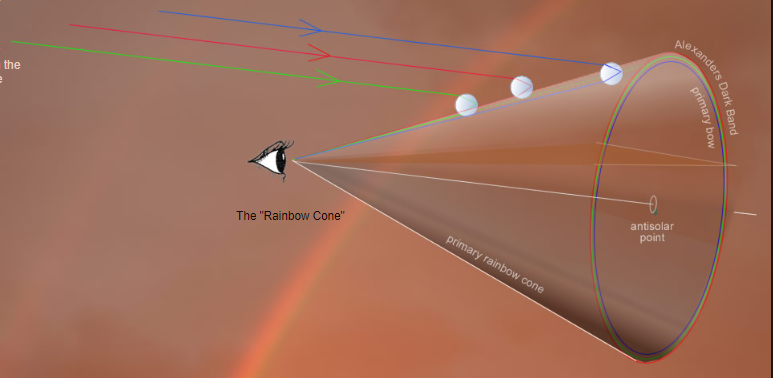OPOD - Rainbow Disk
OPOD - Rainbow Disk: Unveiling the Hidden Secrets of Rainbows
Rainbows have always fascinated us with their vibrant colors and graceful arcs. But did you know that there is more to a rainbow than meets the eye? In this article, we will delve deeper into the enchanting world of rainbows and uncover the hidden secrets of the rainbow disk.
When sunlight interacts with raindrops in the atmosphere, it undergoes a phenomenon known as refraction. This refraction causes the light to bend as it passes from air to water and then back to air again. As a result, the different wavelengths of light are separated, giving rise to the beautiful colors of the rainbow.
Contrary to what we may have learned in school textbooks, a rainbow is not just a simple ring of light. It is, in fact, a disk. The ring shape that we commonly associate with rainbows is just the outer edge of this disk. The disk extends from the eye to any raindrops that are within a cone shape.
Inside this cone, both the raindrops on the surface and those within glint colored light towards the observer. However, what textbooks often fail to mention is that drops inside the cone glint multiple colors. For example, a drop just inside the cone may glint blue at its most intense minimum deviation condition. Additionally, it sends out two red rays and two rays of all other longer wavelength colors at the same angle. Although these extra colors may be faint, they collectively dilute the blue's spectral purity.
As we move deeper inside the cone, the glinted colors become more similar in intensity. When the sun is reasonably high in the sky, we see a white inner disk. However, during a sunset, when the rays are already reddened, we observe a red inner disk.
The rays of light at minimum deviation are the most intense. For instance, when a drop is at minimum deviation, it lights up the blue part of the primary bow. Simultaneously, it also glints longer wavelength colored rays in the same direction. As the drop moves further inside the rainbow, it glints all colors more or less equally. This phenomenon gives rise to the appearance of white or sunset red light brightening the inside of the bow.
The intricate details of the rainbow disk may not be immediately apparent to the naked eye. However, through careful observation and analysis, photographers like Rafael Schmall have been able to capture these mesmerizing features. By assembling narrower angle images, they have revealed the true complexity of rainbows, showcasing the disk-shaped structure and the variations in color intensity.
In conclusion, rainbows are not just simple rings of light. They are disks that extend from our eyes to the raindrops within a cone shape. Drops inside this cone glint multiple colors, diluting the spectral purity of the most intense color. As we explore deeper inside the rainbow, the glinted colors become more similar in intensity, creating a white or sunset red inner disk. By understanding these hidden secrets, we can appreciate the true beauty and complexity of rainbows that often go unnoticed by the casual observer.

Sunset Rainbow Disk ~ Images by Rafael Schmall ( Photography) in Hungary. The top picture is assembled from narrower angle images. It shows well that there is more to a rainbow than a ring of colours. ©Rafael Schmall, shown with permission.
Raindrops anywhere near the surface of a cone extending from the eye glint coloured light towards the eye and form the ring of rainbow colours.
What school textbooks do not say:
The rainbow is more than a ring of light - it is a disk.
Raindrops inside the cone, as well as those on its surface, glint their light towards the eye. But.. ..drops inside the cone glints many colours. At right a drop just inside the cone is glinting blue at the most intense minimum deviation condition. It also sends out at the same angle two red rays and two rays of all other longer wavelength colours. The extra colours are faint but collectively they dilute the blue's spectral purity.
Deeper still inside the cone the colours glinted become more and more of similar intensity. We see a white inner disk when the sun is reasonable high and red one in the already reddened rays of a sunset.

Rays at minimum deviation are the most intense. At left the blue ray is at minimum deviation and this drop lights the blue part of the primary bow.
The drop also glints longer wavelength coloured rays at the same direction.
When the drop is well inside the rainbow it glints all colours more or less equally and we see this as white (or sunset red) light brightening the inside of the bow.

Note: this article has been automatically converted from the old site and may not appear as intended. You can find the original article here.
Reference Atmospheric Optics
If you use any of the definitions, information, or data presented on Atmospheric Optics, please copy the link or reference below to properly credit us as the reference source. Thank you!
-
<a href="https://atoptics.co.uk/blog/opod-rainbow-disk/">OPOD - Rainbow Disk</a>
-
"OPOD - Rainbow Disk". Atmospheric Optics. Accessed on November 26, 2024. https://atoptics.co.uk/blog/opod-rainbow-disk/.
-
"OPOD - Rainbow Disk". Atmospheric Optics, https://atoptics.co.uk/blog/opod-rainbow-disk/. Accessed 26 November, 2024
-
OPOD - Rainbow Disk. Atmospheric Optics. Retrieved from https://atoptics.co.uk/blog/opod-rainbow-disk/.